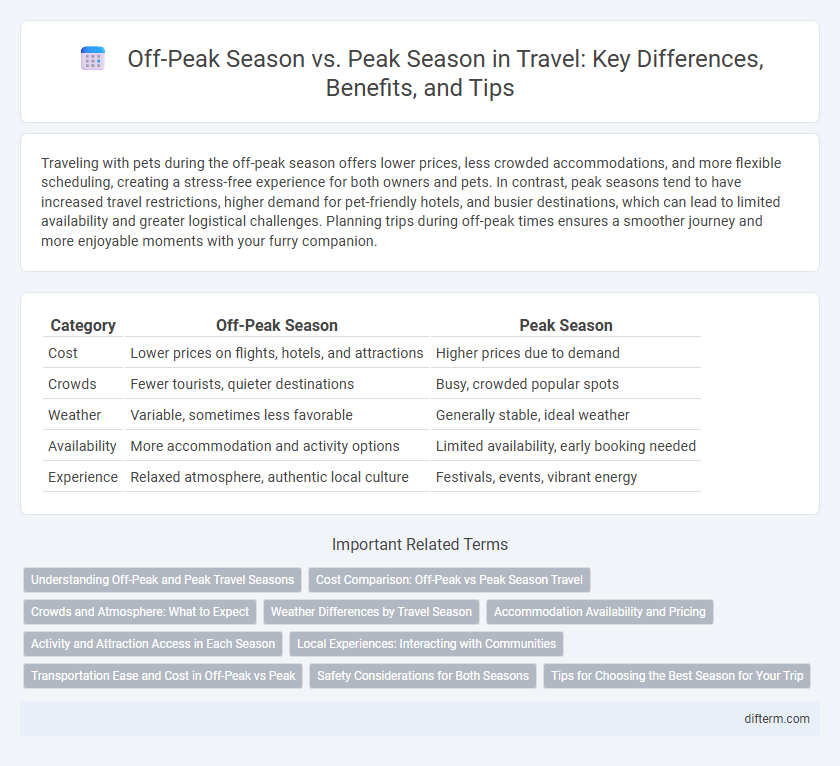Traveling with pets during the off-peak season offers lower prices, less crowded accommodations, and more flexible scheduling, creating a stress-free experience for both owners and pets. In contrast, peak seasons tend to have increased travel restrictions, higher demand for pet-friendly hotels, and busier destinations, which can lead to limited availability and greater logistical challenges. Planning trips during off-peak times ensures a smoother journey and more enjoyable moments with your furry companion.
Table of Comparison
| Category | Off-Peak Season | Peak Season |
|---|---|---|
| Cost | Lower prices on flights, hotels, and attractions | Higher prices due to demand |
| Crowds | Fewer tourists, quieter destinations | Busy, crowded popular spots |
| Weather | Variable, sometimes less favorable | Generally stable, ideal weather |
| Availability | More accommodation and activity options | Limited availability, early booking needed |
| Experience | Relaxed atmosphere, authentic local culture | Festivals, events, vibrant energy |
Understanding Off-Peak and Peak Travel Seasons
Off-peak travel seasons usually occur during the shoulder months or winter periods when tourist demand is significantly lower, resulting in cheaper flights and accommodations. Peak travel seasons coincide with holidays, summer months, and major events when destinations experience high visitor influx and prices surge. Understanding these seasonal patterns enables travelers to optimize budgets, avoid crowds, and choose ideal times for activities and sightseeing.
Cost Comparison: Off-Peak vs Peak Season Travel
Traveling during the off-peak season typically offers significant cost savings on flights, accommodations, and attractions compared to the peak season. Hotel rates can drop by 30-50%, while airfare prices often decrease by 20-40%, making off-peak travel a budget-friendly choice. Avoiding peak season crowds also translates into better deals and more availability, enhancing overall travel value.
Crowds and Atmosphere: What to Expect
Off-peak season travel offers fewer crowds, creating a more relaxed and intimate atmosphere at popular destinations, with shorter lines and less congestion. Peak season attracts larger crowds, resulting in bustling environments, busier attractions, and a vibrant, energetic atmosphere. Tourists seeking tranquility often prefer off-peak times, while those wanting lively social scenes tend to visit during peak months.
Weather Differences by Travel Season
Traveling during the off-peak season offers milder weather conditions with fewer crowds, allowing for more comfortable exploration and better accommodation availability. Peak season often brings warmer temperatures and sunny skies, ideal for beach destinations but also higher humidity and more tourist congestion. Understanding these weather differences by travel season helps travelers choose the best time for their preferred climate and activities.
Accommodation Availability and Pricing
Accommodation availability is significantly higher during the off-peak season, allowing travelers to choose from a wider range of hotels, vacation rentals, and hostels. Pricing for lodging generally drops by 20-50% compared to peak season rates, offering substantial savings on nightly stays. In peak season, limited room availability often leads to higher prices and less flexibility in booking options.
Activity and Attraction Access in Each Season
During peak season, popular attractions and activities experience high demand, often leading to crowded venues and longer wait times, which may limit the quality of the visitor experience. Off-peak season offers greater accessibility to landmarks, tours, and outdoor adventures with reduced crowds, allowing travelers to enjoy a more relaxed and personalized experience. Seasonal variations also affect availability and operation hours of certain attractions, making it essential to plan according to activity schedules for optimum access.
Local Experiences: Interacting with Communities
Traveling during the off-peak season offers a richer local experience by providing more opportunities to interact with communities without the rush of tourists. Residents tend to be more welcoming and accessible, allowing for authentic cultural exchanges and participation in traditional events. In contrast, peak season crowds often limit genuine interactions, as locals may be overwhelmed or focused on catering to high volumes of visitors.
Transportation Ease and Cost in Off-Peak vs Peak
Traveling during the off-peak season offers significantly lower transportation costs due to decreased demand, with airfare and train tickets dropping by up to 40% compared to peak season. Off-peak travel also means fewer crowds, leading to easier access to public transit and less congestion on roads, resulting in faster, more relaxed journeys. In contrast, peak seasons often bring inflated prices and crowded transport hubs, causing delays and stress despite wider availability of services.
Safety Considerations for Both Seasons
Travel safety during off-peak seasons often improves due to fewer crowds, reducing the risk of theft and enabling quicker access to medical and emergency services. Peak season travel, while appealing for its vibrant atmosphere and full-service availability, can increase exposure to common safety hazards like crowded public spaces and higher crime rates. Travelers should consider local crime statistics and seasonal weather patterns to maintain safety regardless of the travel period.
Tips for Choosing the Best Season for Your Trip
Travelers seeking affordable rates and fewer crowds should opt for the off-peak season when hotel prices drop significantly and popular attractions are less congested. For those prioritizing ideal weather conditions and vibrant local events, the peak season offers optimal climate and cultural experiences despite higher costs and increased tourists. Researching destination-specific climate patterns and event calendars helps in selecting the best season tailored to individual preferences and budget constraints.
off-peak season vs peak season Infographic

 difterm.com
difterm.com